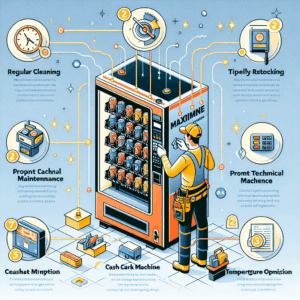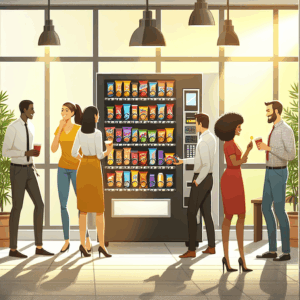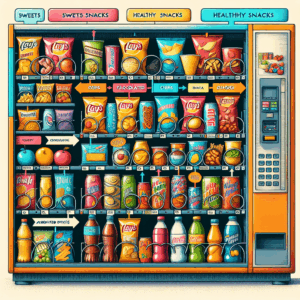Price Sensitivity in Vending Machines
Understanding the Consumer’s Mind
When it comes to vending machines, the price sensitivity of consumers is a major aspect. From my own experience analyzing various consumer markets, it’s clear that every nickel matters. Customers often have a set expectation of what a product should cost, and any significant deviation can cause dissent.
One way to tackle this issue is by keenly observing the existing price points in nearby stores or vending machines, understanding the average spend, and then setting competitive prices. It’s like a dance where you find the beat and move accordingly, ensuring you don’t step on any toes.
Sometimes, innovation plays a role. Implementing subtle price changes allows businesses to experiment with what works best. Always be ready to pivot and reassess based on consumer reactions. It’s like finding the sweet spot where price meets consumer expectations.
The Impact of Price Changes
Adjusting prices on vending machines can be a delicate balance. Even a little change can tip the scales between a regular purchase and a lost customer. It’s crucial to maintain the trust you’ve built with your consumers.
In all my marketing trials, I’ve found that gradual price adjustments, rather than abrupt changes, allow consumers to adapt without feeling cheated. Communication is key, explaining why the price increases, so customers feel informed and valued.
Keep an open dialogue with consumers through feedback mechanisms. This allows for a better understanding of consumer thresholds and what’s considered price gouging. It’s about building a relationship, not a one-time transaction.
Strategies for Price Optimization
Setting the right price is an art form. It requires a blend of data analysis, consumer psychology, and a sprinkle of gut instinct. Always monitor sales data closely to see how price changes affect purchase patterns.
A mix of competitive analysis and demand forecasting can offer insights into optimal pricing strategies. It’s like having a crystal ball that gives glimpses into future trends and behaviors.
Finally, consider the psychological pricing tricks—like pricing something at $1.99 instead of $2.00. This tiny change can surprisingly influence consumer behavior positively, and it’s a nifty hack to keep in your marketing toolkit.
Location-Based Pricing Dynamics
Strategically Positioning Your Machines
The location of a vending machine dramatically influences its pricing strategy. From my travels and explorations in different markets, I’ve noticed that what works in one place doesn’t necessarily work in another.
In high-traffic areas such as airports or malls, where convenience trumps cost, slightly higher prices can often be acceptable. It’s about knowing when your audience is likely to care more about accessibility than price.
The lesson here is to tailor your pricing based on the location’s demographics and consumer behavior. It’s like being a chameleon, adapting seamlessly to your surroundings to offer the best-fit prices.
The Influence of Demographics
Demographics in a location play a massive role in determining price points. If you place a vending machine in a university campus, for instance, cater to budget-conscious students with affordable pricing.
Careful demographic analysis helps better understand who’s buying your product and at what price point. It’s like piecing together a puzzle to find where each piece perfectly fits.
Adjust your offerings to fit the target demographic. This might mean offering energy drinks in a gym or snacks in a commuter station. It’s all about aligning your offerings with consumer expectations for a holistic vending experience.
The Role of Competitors
The competitive landscape dramatically affects pricing strategies for vending machines. Knowing fellow players and their moves is critical. It’s like a chess game where every move counts towards who ultimately gains control over the board.
Pricing lower than nearby options might attract price-sensitive consumers, but it might also lead to a race to the bottom. Instead, focus on value addition aspects, whether it’s through unique product offerings or bundling deals.
Continually scout your competition. What are they offering, how are they pricing, and what’s their unique selling proposition? These are key data points you need to sculpt your pricing strategy adeptly.
Consumer Behavior and Purchase Patterns
Decoding Consumer Habits
Understanding consumer behavior is like cracking a code. With consistent observation, it’s about recognizing patterns in purchases, times, and product preferences. I recall spending late nights poring over sales data to unveil correlations and consumer idiosyncrasies.
Consumers lean towards products that fit into their daily lifestyles. For instance, commuters in transit locations require quick snacks or beverages, while those in waiting areas might want larger items to kill time.
The challenge is to anticipate these needs and adjust the machine’s inventory accordingly. It’s a dynamic process that requires continual learning and adaptation to what your consumer desires.
Adapting to Purchase Shifts
Consumer preferences are not set in stone. Over the years, I’ve seen it all—products that were top sellers turned obsolete when a new trend emerged. Being flexible and quick to adapt is key to maintaining relevance.
Sudden shifts necessitate quick restocks of trendy items or, conversely, phasing out products that no longer sell. It’s akin to riding a wave, requiring balance and agility to avoid being swept under by consumer disinterest.
Regularly updating product lines based on frequent data analysis helps stay ahead of consumer trends. It might require more effort, but keeping a pulse on consumer habits is your ticket to sustained success.
The Psychology Behind Purchases
Human psychology plays an intricate role in determining how, why, and when people buy. Understanding this can be a game-changer. For some, vending machines offer a chance to indulge in something convenient yet satisfying.
Impulse purchases, for example, are quite common. Be it a sudden sweet craving or a spur-of-the-moment decision, capturing these instances can lead to increased sales. It’s about crafting a product mix that spurs these spontaneous purchases.
Appealing to emotions through branding, product presentation, or even the machine’s aesthetics can greatly influence purchase decisions. By tapping into consumer psychology, businesses can foster more connections and enhance customer retention.
Technological Innovations in Vending Machines
Embracing Change
Technology has dramatically shaped vending machines in recent years, creating ample opportunities for growth. Seeing new payment solutions like contactless payments and apps revolutionizing the industry thrills me!
It’s imperative to keep abreast of technological advancements and evaluate which could be integrated into your vending machine operations. It’s like upgrading your toolkit, ensuring you’re better equipped to handle modern-day consumer expectations.
Don’t shy away from investing in technology. It’s the future, and embracing these innovations could boost sales, improve operations, and most importantly, enhance customer satisfaction.
Leveraging Data Analytics
Data is the new oil in today’s vending world. The ability to track purchases, inventory, and machine performance offers a wealth of information to shape better business strategies. With every transaction, there’s data gold waiting to be mined.
Diving into analytics helps understand which products are popular, when peak sales occur, and how to plan inventory better. It’s almost like having a map, where every data point brings you closer to understanding your customers’ needs.
Leveraging this data not only improves operational efficiency but also enhances the consumer experience by ensuring the desired products are always available. It’s an edge every vending business should strive to secure.
Fostering Innovation
Innovation is at the heart of any successful vending machine strategy. From new products and flavors to unique machine interfaces, there’s always room for creativity. It’s an open canvas, waiting for bold strokes of innovation.
Some businesses set themselves apart by offering customizable options, like coffee machines that allow personalization based on preferences. Staying ahead is about being unafraid to experiment and push boundaries.
Continually exploring new ideas and fostering a culture of innovation can drive a brand forward, ensuring it stays relevant and captivating for its audience. The goal is to excite and engage the consumer every step of the way.
FAQs
What impacts pricing in vending machines the most?
Various factors impact pricing, including location, consumer demographics, and competitor offerings. Knowing your audience and their expectations helps set prices that satisfy both business goals and consumer demands.
Why are vending machines priced differently across locations?
Vending machines are strategically priced based on the demographics and demand at different locations. High-traffic or convenience-focused areas often see higher pricing due to ease and accessibility.
How does technology influence vending machine businesses?
Technology enhances operational efficiency, provides data insights, and improves customer experiences. Innovations like contactless payments and data analytics optimize processes and adapt to modern consumer trends.
Why is consumer behavior analysis significant for vending businesses?
Understanding consumer behavior helps tailor product offerings, set appropriate pricing, and respond quickly to changes. It ensures that the business stays aligned with consumer needs and market trends, driving success.



